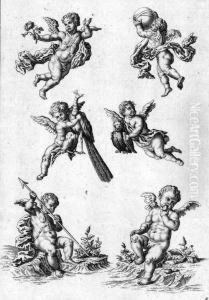Johann Christoph Weigel Paintings
Johann Christoph Weigel was a notable figure in the world of European art and engraving during the late 17th and early 18th centuries. Born in 1654 in the city of Redwitz, part of the Holy Roman Empire, Weigel embarked on a career that would see him become both a prolific engraver and a publisher. His work and influence spanned across various realms of visual culture, including maps, book illustrations, and technical and scientific diagrams, marking him as a versatile artist of his time.
Weigel's journey into the arts led him to Nuremberg, a city with a rich history in printmaking and publishing. It was here that he established himself and began to collaborate with numerous artists and authors. Nuremberg, being a hub for scholars, artists, and craftsmen, provided the perfect backdrop for Weigel's talents to flourish. His engravings were not just limited to artistic endeavors; they also served educational purposes, illustrating textbooks and academic publications with detailed and precise imagery.
Throughout his career, Johann Christoph Weigel worked closely with other prominent figures of the time, including the well-known geographer and publisher Johann Baptist Homann, contributing to the Homann Heirs, a renowned publishing house. Weigel's diverse body of work includes the “Abbildung der gemein-nützlichen Haupt-Stände,” a comprehensive collection of trades and professions illustrated through engravings, which remains a valuable historical document reflecting the socio-economic context of the early 18th century.
Despite the breadth of his work, details about Weigel's personal life remain scarce, allowing his engravings and published works to speak volumes about his contributions to art and society. Johann Christoph Weigel passed away in 1725 in Nuremberg, leaving behind a legacy that has continued to be appreciated by historians and art enthusiasts alike. His work not only demonstrates the skill and precision of engraving as an art form but also provides insight into the cultural and intellectual currents of his time.
